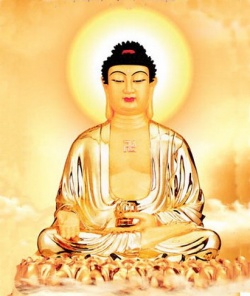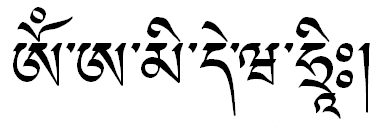Amitābha and Amitāyus Mantra
Amitābha is the Buddha of the Western quarter. His name means "infinite light" - amita (unmeasured, boundless, infinite) + ābha (splendour, light; colour, appearance, beauty - related to bha : light, lustre, splendour; a name for the planet Venus.).
He is usually depicted as a bhikṣu with his hands in the dhyana mudra. He is deep red in colour. Another form common in the Western Buddhist Order shows him with his right hand holding up a full red lotus, while his left hand remains in his lap.
Amitābha dwells in his pureland called Sukhāvatī - the happy realm.which is described in the Sukhāvatīvyūha sūtras (large and small). Amitābha is closely related to Amitāyus - infinite life - who is sometimes described as his "reflex". A mantra for Amitāyus is included below. A visualisation meditation on Amitāyus is described in the Amitāyurdhyāna Sūtra. These Three sūtras are collectively described as the "Pureland Scriptures" and belong to the earliest strata of Mahāyāna texts.
Amitābha's special quality is Compassion, which is balanced in the Mandala of the Jinas by Akṣobhya the Buddha of Wisdom. Amitābha is the head of the Padma, or Lotus family.
mandala of the jinas
| position in mandala | west |
| Colour | red |
| Family | Lotus |
| Mudra | meditation |
| Wisdom | Discriminating Wisdom |
| Emblem | lotus |
| Consort/prajñā | Paṇḍāravāsinī |
Seed Syllable
Amitābha's bīja mantra is hrīḥ which is ha + ra + ī + ḥ (visarga)
hrīḥ is the seed syllable of Amitābha and so represents the qualities of the Buddha of the western quarter: chiefly meditation and compassion. In Tibet it is also associated with Avalokiteśvara or Chenresig.
Mantra
I've cited the mantra in Siddhaṃ using the correct Sanskrit spelling, but the others using the common Tibetan spelling. Below are two other mantras used in two different Japanese traditions.
Siddhaṃ
Transliteration
oṃ a mi tā bha hrīḥ
oṃ amitābha hrīḥ
Tibetan - Uchen
Lantsa
Devanāgarī
Transliteration
oṃ a mi de va hrīḥ
oṃ amideva hrīḥ
Notes
The word amideva which is used in Tibetan traditions is not as it would seem ‘undying god’, but is due to a Tibetan mispronunciation of Amitābha’s name. Compare the Tibetan transliteration of vajra as badzra. This was pointed out to me by David Leskowitz in an email and is also mentioned by Sangharakshita (1981) Concluding Remarks. Preordination Course 1981 [Tuscany 29.11.81], p.111.
I have also seen Tibetan explanations which say that Dewa (the tibetan spelling) is short for Dewachen the name of Sukhāvatī in Tibetan. Dewa is the Tibetan word for sukha. So it could be that this mantra is a Sanskrit/Tibetan hybrid. However this explanation could be due to transliteration difficulties with Tibetan. The word is more precisely transliterated as "bde ba" (pronounced dewa) and the similarity of pronunciation may just be a coincidence.






